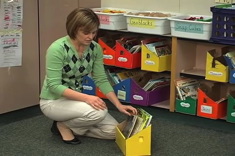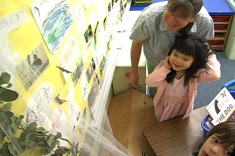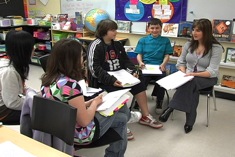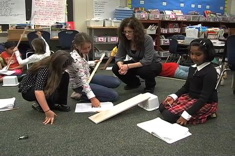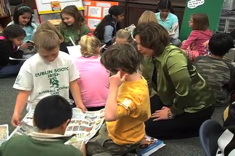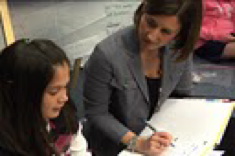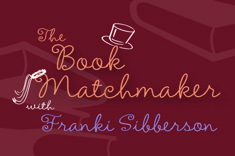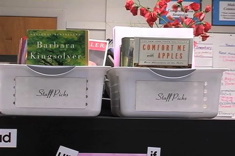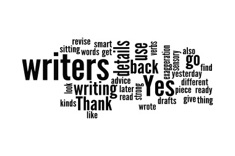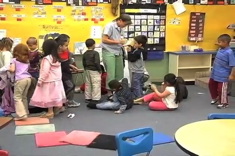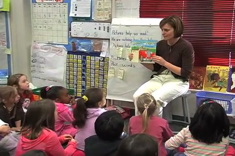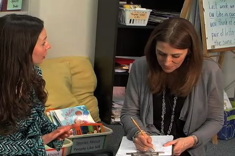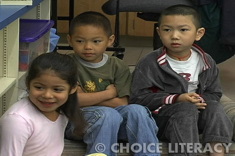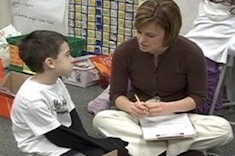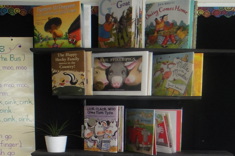Library
Choice Literacy Articles & Videos
The Choice Literacy library contains over 3,000 articles and 900 videos from 150+ contributors. Classic Classroom and Literacy Leadership subscribers have access to the entire library. Content is updated continuously, with five to six new features published each week.
Latest Content
Drawing to Learn: Conferring with Kyle
In this conference with six-year-old Kyle, Ruth Shagoury listens to him explain the stories and meaning behind his drawings during writer's workshop. Kyle's first language is Vietnamese, though English is also spoken in the home.
Injecting Writing into Everything: Cover-up Stories
Cover-up stories involve removing illustrations to heighten awareness of other story elements. Heather Rader explains how the instructional technique works.
Reorganizing Books in the Reading Support Classroom
Katie DiCesare helps her mom, a reading support teacher, reorganize her materials to better serve students.
Family History Inquiry Project: Integrating Technology with Social Studies in First Grade
Julie Johnson explains how a family history inquiry project in her first-grade classroom built technology, literacy, and research skills as students explored many cultures.
Now is Our Season
Shirl McPhillips so eloquently captures the spirit of the light and dark, hopeful and ambivalent, quiet and purposeful time after the holidays in this poem.
Digital Handouts: An Alternative to More Paper and Meetings
Jill Ostrow creates a flexible and practical online tool to support teachers of English language learners.
Making Connections as a Reader and a Scientist
Heather Rader finds that reading is at the heart of scientists’ work.
Seven Minutes of Listening
What can we learn by listening closely to children? Plenty — Andie Cunningham shares insights from seven minutes with a young English language learner.
A Community of Parents: Connecting via Email
Email is a terrific way to communicate with parents—Trish Prentice has practical tips for keeping it simple and saving time when using email.
Quick Take: Katie Doherty on Middle School Reading Workshop Choices
In this two-minute Quick Take video, Katie Doherty explains the choices students have in her sixth-grade reading workshop.
Preschool Morning Message
This five-minute video from Melissa Kolb's preschool classroom shows the value of morning message for teaching literacy skills. Melissa explains the skills children develop during this brief whole-class lesson and sharing time.
Calendaring a Literacy Coach
The joy and challenge of literacy coaching is creating a good structure for the day. Heather Rader has suggestions for short- and long-term planning on the coaching calendar.
The Nuts and Bolts of the Family Inquiry Project
Julie Johnson explains how a family history inquiry project in her first-grade classroom builds technology, literacy, and research skills as students explored many cultures. This article is the second in a two-part series.
Coaching Codes
A code of conduct is created to outline the standards and rules of behavior that guide an organization. Effective codes spell out “unspoken rules” as well, so that everyone can be successful. Heather Rader thinks through what a useful code for coaches might look like.
Science Writing: Small Groups
In this second video in a three-part series, Jennifer Morgan leads her grades 3 and 4 students as they work together in small groups on a science and writing task.
Using Comics in Literacy Workshops
Franki Sibberson works with her 3rd and 4th graders to use comics in the literacy workshop.
Assessment Conferences: Listening to and Learning from Our Students
Research, decide, and teach – Clare Landrigan and Tammy Mulligan use Lucy Calkins’ wise advice in assessment conferences with children.
Revising Titles Minilesson
In this minilesson from Franki Sibberson’s grades 3 and 4 classroom, Franki takes students through the process of selecting and revising titles. She uses the poem “Confessions of a Reader” by Carol Wilcox as a mentor text.
Book Matchmaker: Texts to Build Stamina
In this installment of Book Matchmaker, Franki Sibberson has suggestions for books to build reading stamina in students.
Similes, Metaphors, Homophones and Synonyms: Children’s Books to Teach the Language of Words
Here are some delightful picture books to teach how similes, metaphors, homophones and synonyms work.
Building the Reading Community Among Teachers
Jennifer Allen shares a few strategies for building the reading community beyond individual classrooms in your school. Book swaps, a shared staff novel, and family literacy breakfasts all reinforce the most important aspect of reading – it should be pleasurable and engrossing, no matter the age of the learner.
Language Patterns: Reflecting with Transcripts and Wordle
If you are familiar with Wordle, you already know it is a great free tool on the web for creating “word clouds” – visual representations of language. Heather Rader uses Wordle in her literacy coaching to give new and veteran teachers a succinct and powerful visual representation of their teaching language.
Characters I Know Too Well
Books with themes of sexual abuse may be the most difficult for many of us to grapple with, if only because the issue horrifies us. Yet for some abused teens, a book may be the needed catalyst for breaking their silence about what's going on outside school. Andie Cunningham shares an annotated booklist on this tough topic.
Daily Tidbits: Professional Development in Small Bites
Jennifer Jones suggests an easy way to provide bits of useful professional development to colleagues.
Digging Deeper with Rereading
In this video from Katie DiCesare’s first-grade classroom, Katie uses the strategy of rereading to help students look more closely at words—in this case, words that rhyme.
Supporting Successful First-Year Coaches
Heather Rader gets the inside word from novice literacy coaches about the support they need to thrive.
Getting to Know Multilingual Learners at the Start of the Year
If you’re unsure about working with multilingual learners, Stella Villalba has some reassuring advice for you.
Conferring in First Grade
This nine-minute video from Katie DiCesare’s first-grade classroom demonstrates a range of conferring in the midst of writing workshop.
The Email Mirror and Literacy Coaching
Are you a minimalist when it comes to email, or do you tend to send rambling and reflective posts? No matter your email style, it likely is a match for some of your colleagues, and a barrier to communication for others.
Save the Picture Books!
Are picture books endangered species? Sales are plummeting, in part because parents and teachers are pushing students into chapter books at ever-younger ages. Shari Frost turns a critical eye on her own practice, and brainstorms practical ways to promote the value of picture books in classrooms.
Browse Content By
Type
Category
- Assessment Tools
- Big Fresh Archives
- Booklists
- Choice Numeracy
- Classroom Design
- Common Core
- Community Building
- Conferring
- Content Literacy
- Digital Literacy
- English Language Learners
- Equity
- Family Relations
- Free Samples
- Guiding Groups
- Leadership
- Literacy Coaches
- Mentor Texts
- Minilessons
- New Teacher Mentors
- Podcasts
- Poetry
- Quote Collections
- Reading Strategies
- Self Care
- Struggling and Striving Learners
- Talking and Listening
- Teacher Study Groups
- Teaching Reading
- Teaching Writing
- Word Study and Vocabulary
Author
- Melissa Quimby
- Nawal Qarooni
- Gwen Blumberg
- Julie Cox
- The Lead Learners
- Hannah Tills
- Josie Stewart
- Ruth Metcalfe
- Mallory Messenger
- Becca Burk
- Jodie Bailey
- Vivian Chen
- Mary Brower
- Tiffany Abbott Fuller
- Stephanie Affinito
- Ruth Ayres
- Leigh Anne Eck
- Heather Fisher
- Shari Frost
- Julie Johnson
- Suzy Kaback
- Gigi McAllister
- Shirl McPhillips
- Melanie Meehan
- Cathy Mere
- Debbie Miller
- Tara Barnett and Kate Mills
- Tammy Mulligan
- Dana Murphy
- Bitsy Parks
- David Pittman
- Brenda Power
- Heather Rader
- Matt Renwick
- Mandy Robek
- Christy Rush-Levine
- Gretchen Schroeder
- Jen Schwanke
- Brian Sepe
- Katherine Sokolowski
- Stella Villalba
- Jennifer Vincent
Grade Level
Choice Literacy Membership
Articles
Get full access to all Choice Literacy article content
Videos
Get full access to all Choice Literacy video content
Courses
Access Choice Literacy course curriculum and training



